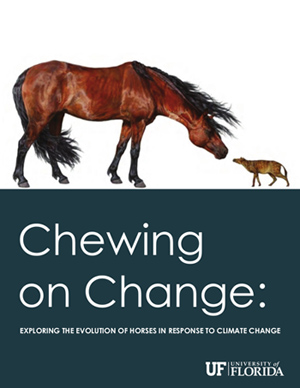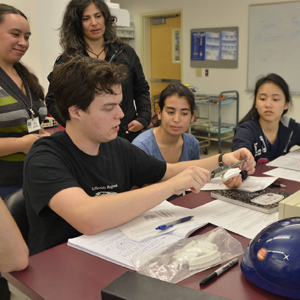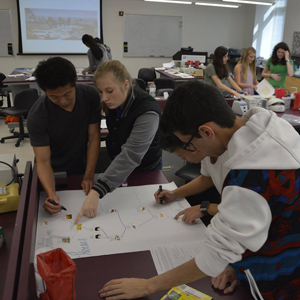By Dawn Mitchell | PCP PIRE Project Assistant

In the September 2014 edition of the eNewsletter, Sean Moran, a STEM-content specialist with PCP PIRE, detailed his experience implementing a new K-12 lesson plan on horse evolution. The first implementation, which had students measure real fossil horse teeth and casts with calipers, provided students with an activity not unlike one performed by professional paleontologists trying to discover relationships between organisms and their environment.
Since then, the “Chewing on Change” curriculum itself has evolved, using new materials in order to increase its accessibility and ease of use. Instead of real fossils and casts, the lessons now utilize 3D prints of fossil horse teeth that can be easily produced in large quantities. 3D scans of the teeth are also free to download from MorphoSource, for others interested in printing their own models. The curriculum has been presented at several professional meetings and conferences and is now being field tested by over 23 teachers in 9 states who work with a total of ~1500 students.

For the last few months, I have been helping Sean Moran and Julie Bokor, a Ph.D. student in Science Education at UF’s College of Precollegiate Education and Training (CPET), with preparing 3D-printed horse teeth for use in the classroom and recording responses from students’ curriculum assessments. Before and after the lesson plans are implemented, the students are assessed on knowledge relevant to the concepts taught in the lessons. Once the assessments from the field tests are fully recorded, the curriculum team will have a large dataset that they can use to assess how well the curriculum teaches its concepts and what improvements need to be made. It was illuminating to read over the curriculum and then see how the students responded to its implementation, and I was interested in seeing the curriculum in action.

I was able to attend an implementation of the curriculum on the UF campus on February 24. Sean, Julie, and I taught the first and third lessons in the curriculum to 17 AP Biology students from West Shore High School of Melbourne, FL. Helping out with the lessons was a lot of fun, and it was cool to see how the students used their measurements and the information in their handouts to draw conclusions about horse evolution and its relationship to climate change. I am excited to see how the curriculum continues to evolve and teach students about evolution in an engaging, accessible way.
You can find the Chewing on Change horse evolution curriculum on the CPET website: http://www.cpet.ufl.edu/resources/curricula/created-by-fellows/evolution/.
Por Dawn Mitchell | Ayudante del proyecto PCP PIRE
Traducido por Lucy Taylor

En la edición de septiembre 2014 del eNewsletter de PCP PIRE, Sean Moran, un especialista de contenido de ciencias, tecnologías, ingeniería, y matemáticas, que trabaja con PCP PIRE, describió su experiencia de introducir un plan de lección para estudiantes de los grados K-12 sobre la evolución de los caballos. La primera lección proveyó a los estudiantes una actividad muy similar a un proceso hecho por los paleontólogos profesionales cuando intentan a determinar las relaciones entre los caballos y el ambiente en que vivían.

Los estudiantes midieron dientes fosilizados reales de caballos y copias de yeso de los dientes. Desde su principio, el programa mismo ha evolucionado, usando nuevos materiales para aumentar la accesibilidad y facilidad de las lecciones. En lugar de los fósiles reales y las copias de yeso, el programa ahora utiliza copias de los dientes hechas con un imprimador de 3D. Estas copias pueden ser producidas fácilmente. Los escaneos de los dientes pueden ser descargados, gratis, de MorphoSource, para otras personas que quieren imprimir sus propios modelos. El programa ha sido presentado en múltiples reuniones profesionales y conferencias, y ahora está siendo probado por más de 23 profesores en 9 estados, que tienen aproximadamente 1500 estudiantes.
Hace unos meses, yo he estado ayudando a Sean Moran y a Julie Bokor, una estudiante doctorada de la educación de las ciencias, de la Facultad de Educación y Formación Pre-Universidad (CPET en inglés) de la Universidad de Florida (UF). Hemos estado imprimiendo las réplicas de 3D de los dientes de caballo para las lecciones, y anotando las respuestas que entregan los estudiantes como parte del programa. Los estudiantes hacen una pre-evaluación del conocimiento relevante que tienen antes del principio del programa, y una post-evaluación después de participar en las lecciones. Las respuestas de estas dos evaluaciones permiten nuestro equipo a evaluar la eficacia del programa de enseñar la información a los estudiantes. Leer las reacciones de ellos me iluminó, y me interesó verlos aprendiendo.

Yo asistí a una de las sesiones del programa en el campus de UF el 24 de febrero. Sean, Julie, y yo enseñamos las lecciones primera y tercera a 17 estudiantes de biología avanzada del Colegio de West Shore de Melbourne, Florida. Fue divertido ayudar a los estudiantes, y fue chévere verlos usando la información proveída y las medidas que hicieron de los dientes para formar conclusiones sobre la evolución de caballos y la relación que tiene la evolución con el cambio de clima. Estoy emocionada anticipando la evolución de este programa que educa de una manera atractiva y accesible.
El programa y los planes de lección están disponibles en el sitio de CPET: http://www.cpet.ufl.edu/resources/curricula/created-by-fellows/evolution/.